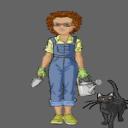Yahoo Answers is shutting down on May 4th, 2021 (Eastern Time) and beginning April 20th, 2021 (Eastern Time) the Yahoo Answers website will be in read-only mode. There will be no changes to other Yahoo properties or services, or your Yahoo account. You can find more information about the Yahoo Answers shutdown and how to download your data on this help page.
Trending News
Making a soil less potting mix?
Iam going to start tomato and pepper seeds. What I have on hand is peat moss pearllite and fine sand. What would be the best ratio? I do want to bottom water.
I have worked with peat before I promis I will not let it dry out and I will pre wet it.
For my pots I am using paper egg cartons. The seedlings will be potted up later.
5 Answers
- 1 decade agoFavorite Answer
I would use 2 parts peat to one part perlite. The sand will be too heavy for egg cartons.
Once they have got their true leaves, pot them on into some compost, either ready made or make some from your supplies- 3 parts peat, 1 part sand, plus general fertilizer ( it will have nitrogen,phosphate and potash plus trace elements) See packet for quantities to add.
- characterLv 51 decade ago
this list of recipes may help
http://www.organicgardening.com/featureprint/1,775...
When I operated my greenhouse, I would make a slight depression, put in the seed and then dust over with vermiculite. Vermiculite will not "crust". Pre-wetting is good, bottom water is ok, misting from the top several times a day is often over looked and highly recommended. I would not use the sand in the starter mix myself, or compost. The sand is heavy and while good for drainage, is useless to retain moisture. I love compost in the mix later, but unless you bake it to sterilize it, (which stinks horribly), it is likely to increase "damp off", a fungal problem causing major loss of seedlings..
Good luck
- 1 decade ago
Good compost is important. Compost is a key ingredient in most organic potting mixes, providing an organic source of nutrients, reducing reliance on the finite global supplies of peat, and supporting recycling of organic residues. In addition to using compost that meets organic standards, it is essential to use high quality compost that will result in good plant performance. Since compost can vary from batch to batch, there can also be variation in organic potting mix performance, even when it’s made using the same recipe. That’s one reason why conventional commercial potting mixes rarely contain compost.
When making or buying compost for your potting mix, try to have it ready at least six months before you’ll need it. For spring transplant production, compost should be made the previous summer and allowed to age through the fall and winter. That allows time for the compost to mature, which means that nutrients are stabilized, phytotoxic compounds have degraded, and in some cases, beneficial microbes have built up that can help suppress plant disease. It is important to test the compost you plan to use in a potting mix for nutrient content, pH, soluble salts, and indicators of maturity like C:N ratio. Compost tests and recommendations are widely available from soil testing labs.
- pcbeachratLv 71 decade ago
I use 1/3 vermiculite,1/3 perlite..1/3 peat..I have my tomatoes ,peppers,okra,cantaloupes, watermelon and many other items already under a grow lite inside ...
- How do you think about the answers? You can sign in to vote the answer.
- Anonymous1 decade ago
perlite





